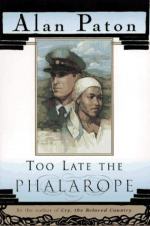|
This section contains 295 words (approx. 1 page at 400 words per page) |

|
Too Late the Phalarope Summary & Study Guide Description
Too Late the Phalarope Summary & Study Guide includes comprehensive information and analysis to help you understand the book. This study guide contains the following sections:
This detailed literature summary also contains Bibliography and a Free Quiz on Too Late the Phalarope by Alan Paton.
Following his successful debut with Cry, the Beloved Country, Alan Paton wrote a second novel set in South Africa, Too Late the Phalarope. This second novel continues to be overshadowed by its predecessor, despite considerable critical opinion that it is the more polished of the two. Both books carry Paton's imprint in their portrayal of unfairness in a system designed to keep the races separate. As a dedicated political activist, Paton saw his writing as a means to a higher end. Too Late the Phalarope clearly exhibits the author's disgust with injustice in a supposedly "moral" society.
Cry, the Beloved Country centers on the black experience in South Africa, while Too Late the Phalarope depicts the lives of Afrikaners (descendants of Dutch settlers who traveled to South Africa three hundred years ago). Specifically, Paton depicts a heroic protagonist, Pieter van Vlaanderen, grappling with private issues in the face of a strict law forbidding interracial sexual relationships. Pieter's internal struggles are intensified by the fact that, as a top-ranking police officer, he represents lawfulness and duty. His inability to resolve his dilemma with self-control leads to his ruin.
Numerous critics regard Too Late the Phalarope as a modern-day Greek tragedy. The story features an extremely virtuous and upright hero whose downfall comes about as the result of his own tragic flaw. Further, secondary characters (such as Pieter's family) are destroyed by forces outside themselves and over which they have no control. The narrator, Sophie, is somewhat removed from the rest of the characters because of her disfigurement, and thus serves as the chorus, commenting on the action of the plot. By updating the Greek tragedy, Paton refers to the universality of human suffering and weakness while demonstrating the dangers of an unjust social structure.
Read more from the Study Guide
|
This section contains 295 words (approx. 1 page at 400 words per page) |

|



